A Conceptual Model to Investigate the Role of Mobile Game Applications in Education during the COVID-19 Pandemic
Abstract
1. Introduction
2. Literature Review
The Role of Mobile Games in the Learning Context
3. Research Design
3.1. Technology Acceptance Model (TAM)
3.2. Technology Utilization Theory (TUT)
4. Methodology
4.1. Participants and Measurement
4.2. Scenario of the Experimental Design
4.3. Experimental Procedure
5. Structural Model Analysis and Results
6. Discussion
Implications of the Study
7. Conclusions
Author Contributions
Funding
Data Availability Statement
Conflicts of Interest
References
- Atwood-Blaine, D.; Huffman, D. Mobile Gaming and student interactions in a Science Center: The future of gaming in science education. Int. J. Sci. Math. Educ. 2017, 15, 45–65. [Google Scholar] [CrossRef]
- Baek, Y.; Touati, A. Exploring how individual traits influence enjoyment in a mobile learning game. Comput. Hum. Behav. 2017, 69, 347–357. [Google Scholar] [CrossRef]
- Almaiah, M.A.; Al-Khasawneh, A.; Althunibat, A. Exploring the critical challenges and factors influencing the E-learning system usage during COVID-19 pandemic. Educ. Inf. Technol. 2020, 25, 5261–5280. [Google Scholar] [CrossRef]
- Almaiah, M.A.; Alamri, M.M.; Al-Rahmi, W. Applying the UTAUT model to explain the students’ acceptance of mobile learning system in higher education. IEEE Access 2019, 7, 174673–174686. [Google Scholar] [CrossRef]
- Almaiah, M.A.; Jalil, M.A.; Man, M. Extending the TAM to examine the effects of quality features on mobile learning acceptance. J. Comput. Educ. 2016, 3, 453–485. [Google Scholar] [CrossRef]
- Alamri, M.M.; Almaiah, M.A.; Al-Rahmi, W.M. The role of compatibility and Task-Technology Fit (TTF): On Social Networking Applications (SNAs) usage as sustainability in higher education. IEEE Access 2020, 8, 161668–161681. [Google Scholar] [CrossRef]
- Bolliger, D.U.; Mills, D.; White, J.; Kohyama, M. Japanese students’ perceptions of digital game use for English-language learning in higher education. J. Educ. Comput. Res. 2015, 53, 384–408. [Google Scholar] [CrossRef]
- Almaiah, M.A.; Alyoussef, I.Y. Analysis of the effect of course design, course content support, course assessment and instructor characteristics on the actual use of E-learning system. IEEE Access 2019, 7, 171907–171922. [Google Scholar] [CrossRef]
- Castillo, R.E.; Cheng, C.J.; Agustin, J.S.; Aragon, M.C.R. Development of an educational mobile game applications for Grade 5 for Knowledge Channel Inc. In Proceedings of the 2019 2nd International Conference on Information Science and Systems, Tokyo, Japan, 16–19 March 2019; pp. 99–104. [Google Scholar]
- Almaiah, M.A.; Al-Khasawneh, A. Investigating the main determinants of mobile cloud computing adoption in university campus. Educ. Inf. Technol. 2020, 25, 3087–3107. [Google Scholar] [CrossRef]
- Almaiah, M.A.; Alamri, M.M.; Al-Rahmi, W.M. Analysis the effect of different factors on the development of mobile learning applications at different stages of usage. IEEE Access 2019, 8, 16139–16154. [Google Scholar] [CrossRef]
- Almaiah, M.A.; Almulhem, A. A conceptual framework for determining the success factors of e-learning system implementation using Delphi technique. J. Theor. Appl. Inf. Technol. 2018, 96, 5962–5976. [Google Scholar]
- Chen, H.-R.; Lin, Y.-S. An examination of digital game-based situated learning applied to Chinese language poetry education. Technol. Pedagog. Educ. 2015, 25, 1–16. [Google Scholar] [CrossRef]
- Cheng, Y.-M.; Lou, S.-J.; Kuo, S.-H.; Shih, R.-C. Investigating elementary school students’ technology acceptance by applying digital game-based learning to environmental education. Australas. J. Educ. Technol. 2013, 29, 1. [Google Scholar] [CrossRef]
- Almaiah, M.A.; Jalil, M.A. Investigating students’ perceptions on mobile learning services. Int. J. Interact. Mob. Technol. iJIM 2014, 8, 31. [Google Scholar] [CrossRef][Green Version]
- Almaiah, M.A.; Alismaiel, O.A. Examination of factors influencing the use of mobile learning system: An empirical study. Educ. Inf. Technol. 2018, 24, 885–909. [Google Scholar] [CrossRef]
- Crompton, H.; Lin, Y.-C.; Burke, D.; Block, A. Mobile digital games as an educational tool in K-12 schools. In Mobile and Ubiquitous Learning. Perspectives on Rethinking and Reforming Education; Yu, S., Ally, M., Tsinakos, A., Eds.; Springer: Singapore, 2017; pp. 3–17. [Google Scholar] [CrossRef]
- Almaiah, M.A.; Al Mulhem, A. Analysis of the essential factors affecting of intention to use of mobile learning applications: A comparison between universities adopters and non-adopters. Educ. Inf. Technol. 2019, 24, 1433–1468. [Google Scholar] [CrossRef]
- Almaiah, M.A. Acceptance and usage of a mobile information system services in University of Jordan. Educ. Inf. Technol. 2018, 23, 1873–1895. [Google Scholar] [CrossRef]
- DaCosta, B.; Seok, S.; Kinsell, C. Mobile game-based learning. In Advanced Methodologies and Technologies in Modern Education Delivery; IGI Global: Hershey, PA, USA, 2019; pp. 809–824. [Google Scholar]
- Davis, F.D.; Bagozzi, R.P.; Warshaw, P.R. User acceptance of computer technology: A comparison of two theoretical models. Manag. Sci. 1989, 35, 982–1003. [Google Scholar] [CrossRef]
- Dele-Ajayi, O.; Strachan, R.; Sanderson, J.; Pickard, A. A modified TAM for predicting acceptance of digital educational games by teachers. In 2017 IEEE Global Engineering Education Conference (EDUCON); IEEE: Manhattan, NY, USA, 2017; pp. 961–968. [Google Scholar]
- Almaiah, M.A.; Jalil, M.A.; Man, M. Empirical investigation to explore factors that achieve high quality of mobile learning system based on students’ perspectives. Eng. Sci. Technol. Int. J. 2016, 19, 1314–1320. [Google Scholar] [CrossRef]
- Alamri, M.M.; Almaiah, M.A.; Al-Rahmi, W.M. Social media applications affecting students’ academic performance: A model developed for sustainability in higher education. Sustainability 2020, 12, 6471. [Google Scholar] [CrossRef]
- De Grove, F.; Bourgonjon, J.; Van Looy, J. Digital games in the classroom? A contextual approach to teachers’ adoption intention of digital games in formal education. Comput. Hum. Behav. 2012, 28, 2023–2033. [Google Scholar] [CrossRef]
- Almaiah, M.A.; Nasereddin, Y. Factors influencing the adoption of e-government services among Jordanian citizens. Electron. Gov. Int. J. 2020, 16, 236–259. [Google Scholar] [CrossRef]
- Alksasbeh, M.; Abuhelaleh, M.; Almaiah, M.A.; Al-Jaafreh, M.; Abu Karaka, A. Towards a model of quality features for mobile social networks apps in learning environments: An extended information system success model. Int. J. Interact. Mob. Technol. iJIM 2019, 13, 75–93. [Google Scholar] [CrossRef]
- Alghazi, S.; Kamsin, A.; Almaiah, M.; Wong, S.; Shuib, L. For sustainable application of mobile learning: An extended UTAUT model to examine the effect of technical factors on the usage of mobile devices as a learning tool. Sustainability 2021, 13, 1856. [Google Scholar] [CrossRef]
- Shawai, Y.G.; Almaiah, M.A. Malay Language Mobile Learning System (MLMLS) using NFC technology. Int. J. Educ. Manag. Eng. 2018, 8, 1–7. [Google Scholar] [CrossRef]
- Althunibat, A.; Binsawad, M.; Almaiah, M.A.; Almomani, O.; Alsaaidah, A.; Al-Rahmi, W.; Seliaman, M.E. Sustainable applications of smart-government services: A model to understand smart-government adoption. Sustainability 2021, 13, 3028. [Google Scholar] [CrossRef]
- Almaiah, M.A.; Al-Zahrani, A.; Almomani, O.; Alhwaitat, A.K. Classification of cyber security threats on mobile devices and applications. In Artificial Intelligence and Blockchain for Future Cybersecurity Applications; Springer: Cham, Switzerland, 2021; pp. 107–123. [Google Scholar]
- Al Amri, M.M.; Almaiah, M.A. Sustainability Model for Predicting Smart Education Technology Adoption Based on Student Perspectives. Int. J. Advance Soft Compu. 2021, 13, 2. [Google Scholar]
- Almaiah, M.A.; Al-Khasawneh, A.; Althunibat, A.; Almomani, O. Exploring the main determinants of mobile learning application usage during Covid-19 pandemic in Jordanian universities. Emerg. Technol. Dur. Era COVID-19 2021, 348, 275–290. [Google Scholar]
- Gholizadeh, M.; Taghiyareh, F.; Alvandkoohi, S. Toward a propensity-oriented player typology in educational mobile games. Int. J. Game Based Learn. 2018, 8, 55–67. [Google Scholar] [CrossRef]
- Herodotou, C. Mobile games and science learning: A comparative study of 4 and 5 years old playing the game Angry Birds. Br. J. Educ. Technol. 2017, 49, 6–16. [Google Scholar] [CrossRef]
- Holden, C.L.; Sykes, J.M. Leveraging mobile games for place-based language learning. Int. J. Game Based Learn. 2011, 1, 1–18. [Google Scholar] [CrossRef]
- Bubukayr, M.A.S.; Almaiah, M.A. Cybersecurity concerns in smart-phones and applications: A survey. In 2021 International Conference on Information Technology (ICIT); IEEE: Manhattan, NY, USA, 2021; pp. 725–731. [Google Scholar]
- Alamer, M.; Almaiah, M.A. Cybersecurity in Smart City: A systematic mapping study. In 2021 International Conference on Information Technology (ICIT); IEEE: Manhattan, NY, USA, 2021; pp. 719–724. [Google Scholar]
- Al Nafea, R.; Almaiah, M.A. Cyber security threats in cloud: Literature review. In 2021 International Conference on Information Technology (ICIT); IEEE: Manhattan, NY, USA, 2020; pp. 779–786. [Google Scholar]
- Almaiah, M.A.; Jalil, M.A.; Man, M. preliminary study for exploring the major problems and activities of mobile learning system: A case study of jordan. J. Theor. Appl. Inf. Technol. 2016, 93, 2. [Google Scholar]
- AlMedires, M.; AlMaiah, M. Cybersecurity in Industrial Control System (ICS). In 2021 International Conference on Information Technology (ICIT); IEEE: Manhattan, NY, USA, 2021; pp. 640–647. [Google Scholar]
- Almudaires, F.; Almaiah, M. Data an overview of cybersecurity threats on credit card companies and credit card risk mitigation. In Proceedings of the 2021 International Conference on Information Technology (ICIT), Amman, Jordan, 14–15 July 2021; pp. 732–738. [Google Scholar] [CrossRef]
- Almaiah, M.A.; Alamri, M.M. Proposing a new technical quality requirements for mobile learning applications. J. Theor. Appl. Inf. Technol. 2018, 96, 19. [Google Scholar]
- Huang, Y.-M. Exploring students’ acceptance of educational computer games from the perspective of learning strategy. Australas. J. Educ. Technol. 2019, 35, 3. [Google Scholar] [CrossRef]
- Huizenga, J.; Admiraal, W.; Akkerman, S.; Dam, G.T. Mobile game-based learning in secondary education: Engagement, motivation and learning in a mobile city game. J. Comput. Assist. Learn. 2009, 25, 332–344. [Google Scholar] [CrossRef]
- Almaiah, M.A. Thematic analysis for classifying the main challenges and factors influencing the successful implementation of e-learning system using NVivo. Int. J. Adv. Trends Comput. Sci. Eng. 2020, 9, 142–152. [Google Scholar] [CrossRef]
- Hwang, G.-J.; Wu, P.-H.; Chen, C.-C.; Tu, N.-T. Effects of an augmented reality-based educational game on students’ learning achievements and attitudes in real-world observations. Interact. Learn. Environ. 2015, 24, 1895–1906. [Google Scholar] [CrossRef]
- Hwang, K.Y.; Kim, H.S. The effects of scaffolding types in wiki-based collaborative learning on creativity. J. Korea Contents Assoc. 2019, 19, 66–78. [Google Scholar]
- Koutromanos, G.; Avraamidou, L. The use of mobile games in formal and informal learning environments: A review of the literature. Educ. Media Int. 2014, 51, 49–65. [Google Scholar] [CrossRef][Green Version]
- Laine, T.H. Mobile educational augmented reality games: A systematic literature review and two case studies. Computers 2018, 7, 19. [Google Scholar] [CrossRef]
- Laine, T.H.; Suk, H. Designing educational mobile augmented reality games using motivators and disturbance factors. In Augmented Reality Games II; Springer: Cham, Switzerland, 2019; pp. 33–56. [Google Scholar] [CrossRef]
- Lai, A.-F.; Shih, S.; Hong, C.-R. Developing a mobile-based digital math game for learning number and calculation in elementary school. In Proceedings of the 2018 2nd International Conference on Education and Multimedia Technology, Okinawa, Japan, 2–4 July 2018; pp. 9–13. [Google Scholar] [CrossRef]
- Molnar, A.; Kostkova, P. Learning about hygiene and antibiotic resistance through mobile games: Evaluation of learning effectiveness. In Proceedings of the 2018 International Conference on Digital Health, Lyon, UK, 23–26 April 2018; pp. 95–99. [Google Scholar]
- Nygren, E.L.; Laine, T.H.; Sutinen, E. Dynamics between disturbances and motivations in educational mobile games. Int. J. Interact. Mob. Technol. 2018, 12, 120–141. [Google Scholar] [CrossRef]
- Nikou, S.; Economides, A. Mobile-based micro-learning and assessment: Impact on learning performance and motivation of high school students. J. Comput. Assist. Learn. 2018, 34, 269–278. [Google Scholar] [CrossRef]
- Prensky, M. Digital natives, digital immigrants. In On the Horizon; MCB University Press: Bingley, UK, 2001; Volume 9, pp. 1–6. [Google Scholar]
- Rashid, N.A.M.; Salleh, S.M.; Noor, N.M. The role of game elements in improving Jawi Skills through a mobile game ‘G-Jawi’. Int. J. Interact. Mob. Technol. iJIM 2018, 12, 20–30. [Google Scholar] [CrossRef]
- Rachels, J.R.; Rockinson-Szapkiw, A.J. The effects of a mobile gamification app on elementary students’ Spanish achievement and self-efficacy. Comput. Assist. Lang. Learn. 2017, 31, 72–89. [Google Scholar] [CrossRef]
- Slussareff, M.; Boháčková, P. Students as game designers vs. ‘just’ players: Comparison of two different approaches to location-based games implementation into school curricula. Digit. Educ. Rev. 2016, 29, 284–297. [Google Scholar]
- Villanueva, K.; Vaidya, J. Power up learning with mobile games: The educational arcade—An innovative approach to learning. In Advancing Mobile Learning in Contemporary Educational Spaces; IGI Global: Hershey, PA, USA, 2019; pp. 209–242. [Google Scholar]
- Wardaszko, M.; Podgórski, B. Mobile learning game effectiveness in cognitive learning by adults: A comparative study. Simul. Gaming 2017, 48, 435–454. [Google Scholar] [CrossRef]
- Wang, Q.; Sun, X. Investigating gameplay intention of the elderly using an Extended Technology Acceptance Model (ETAM). Technol. Forecast. Soc. Chang. 2016, 107, 59–68. [Google Scholar] [CrossRef]
- Yadav, A.K.; Oyelere, S.S. Contextualized mobile game-based learning application for computing education. Educ. Inf. Technol. 2020, 26, 2539–2562. [Google Scholar] [CrossRef]
- Al Amri, M.M.; Almaiah, M.A. The use of mobile gamification technology for sustainability learning in Saudi higher education. Int. J. Adv. Trends Comput. Sci. Eng. 2020, 9, 5. [Google Scholar]
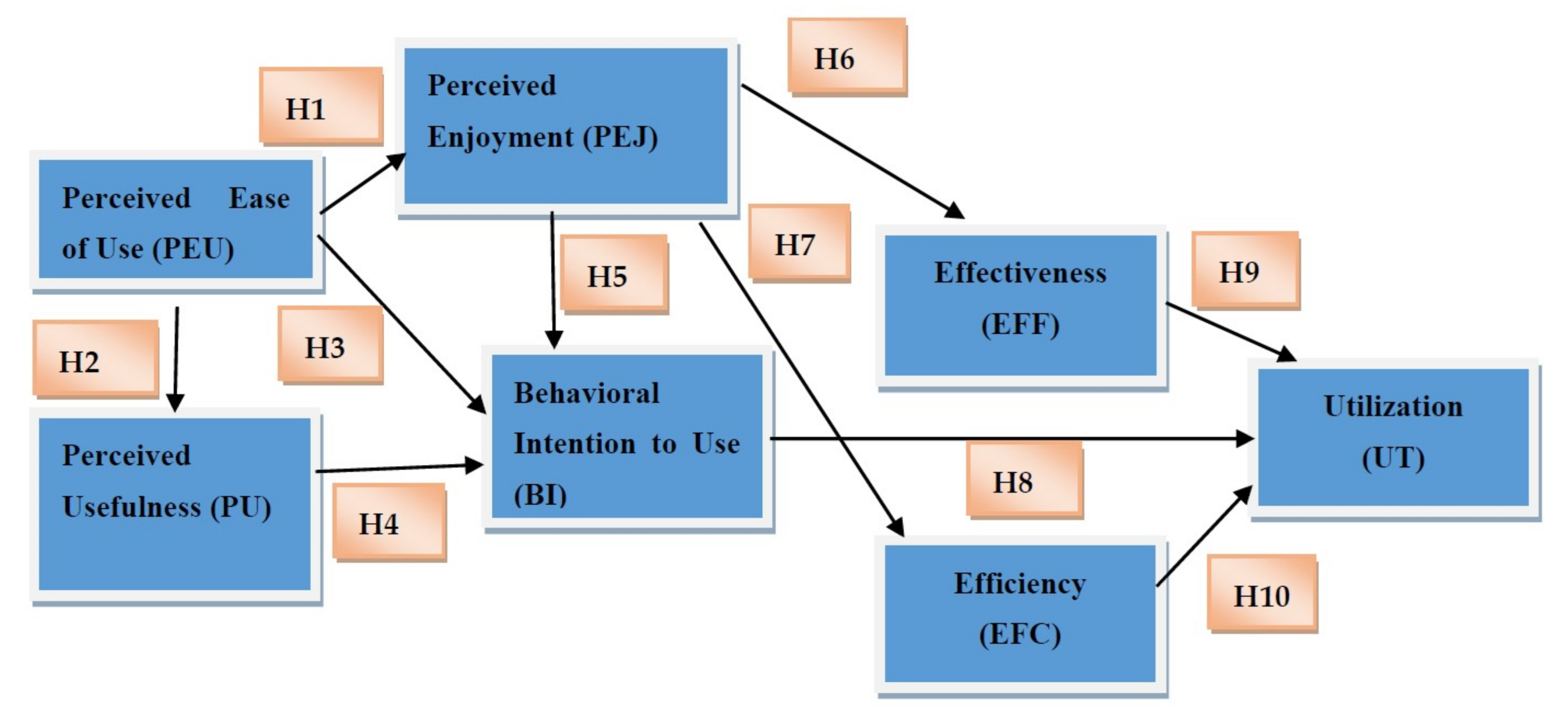
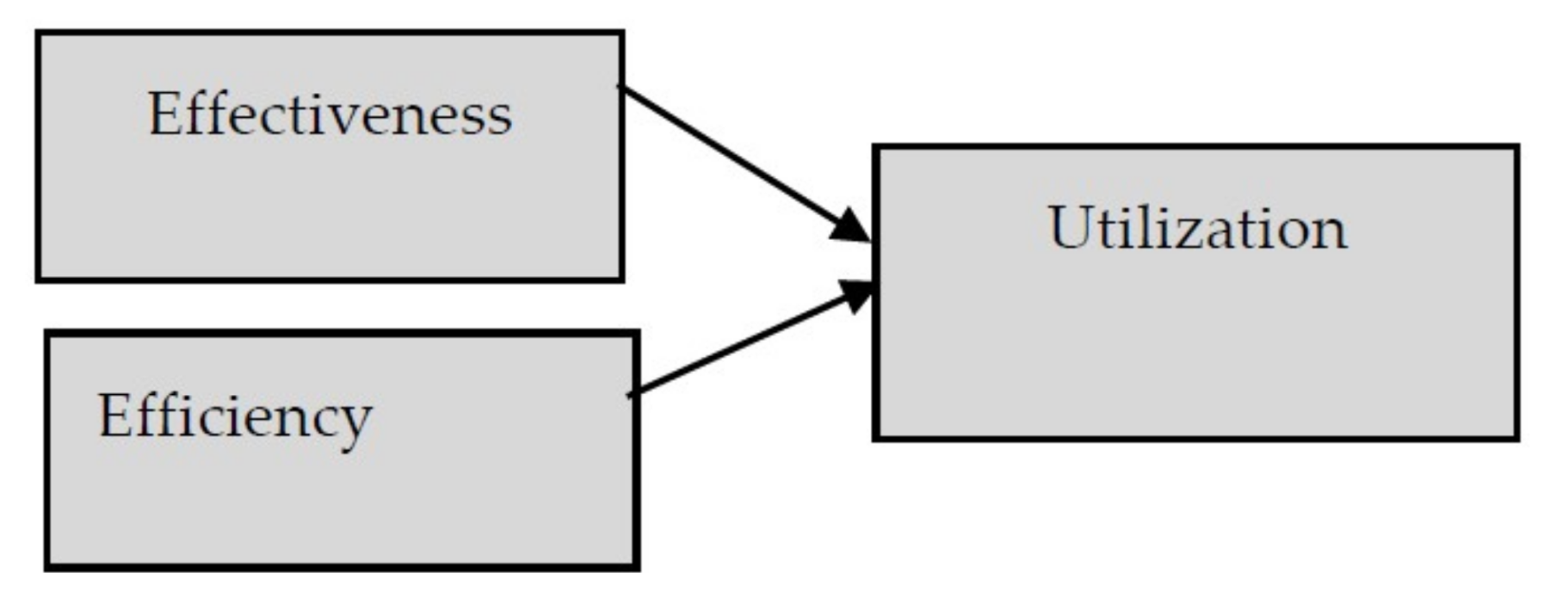
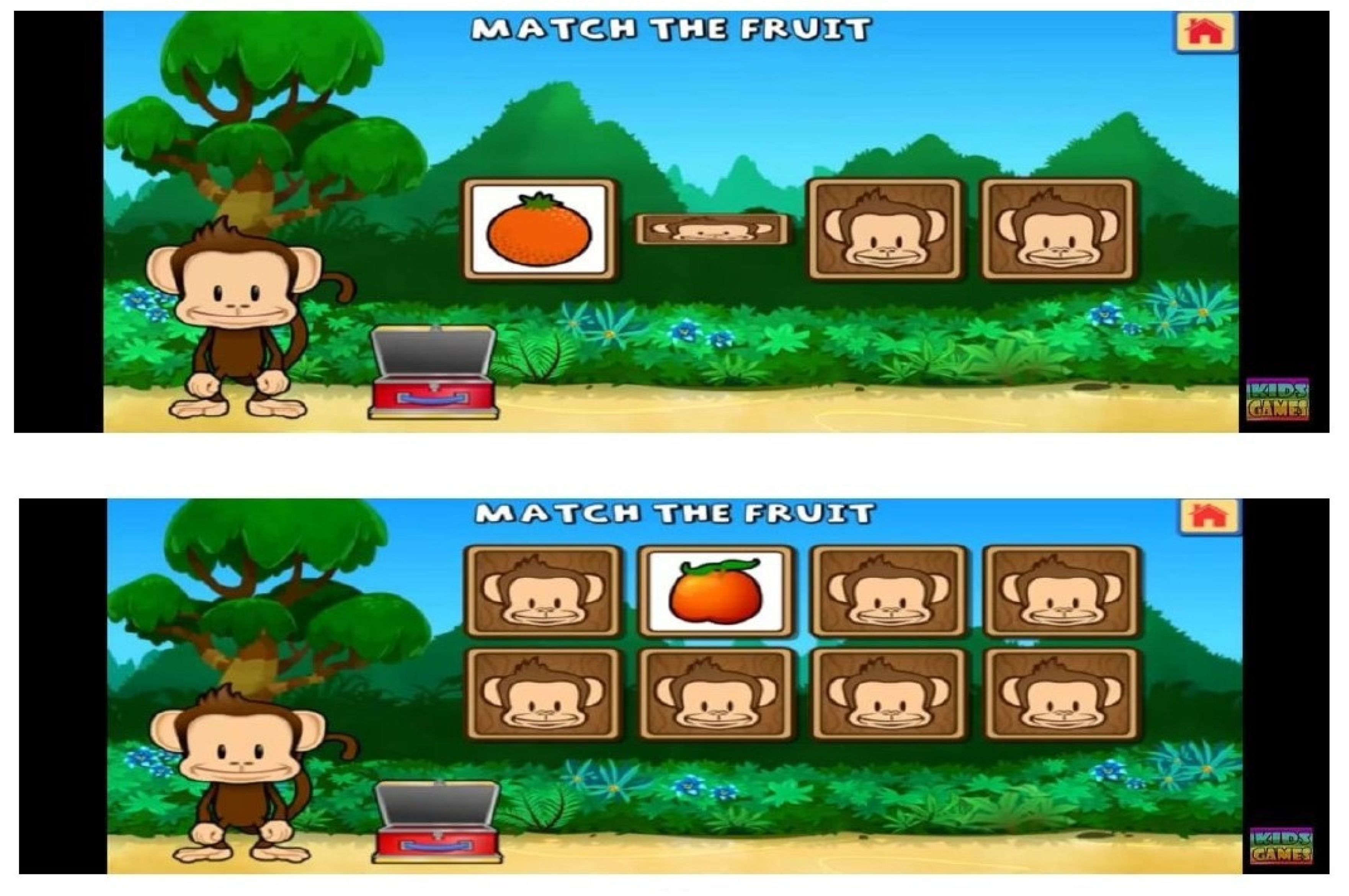
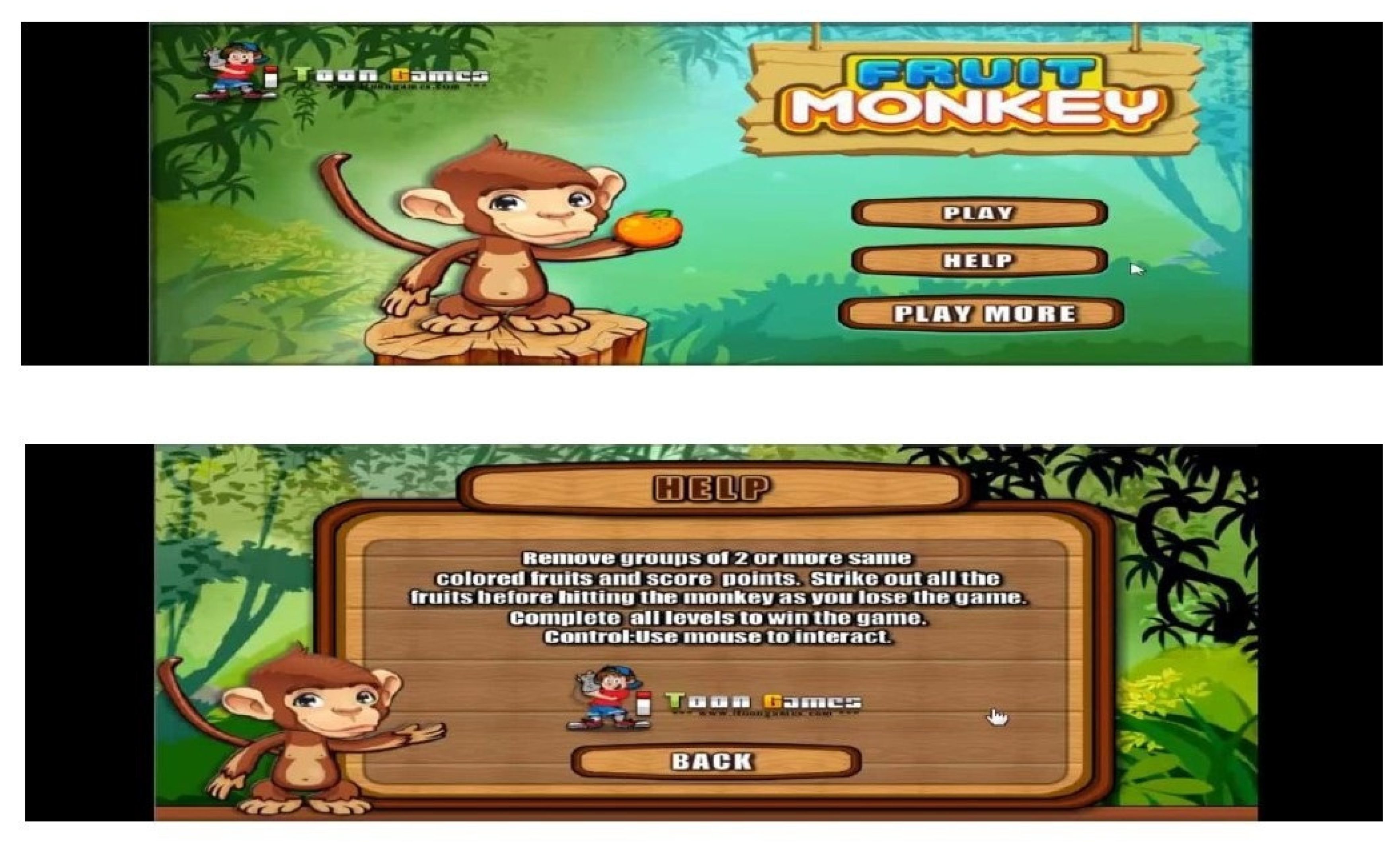
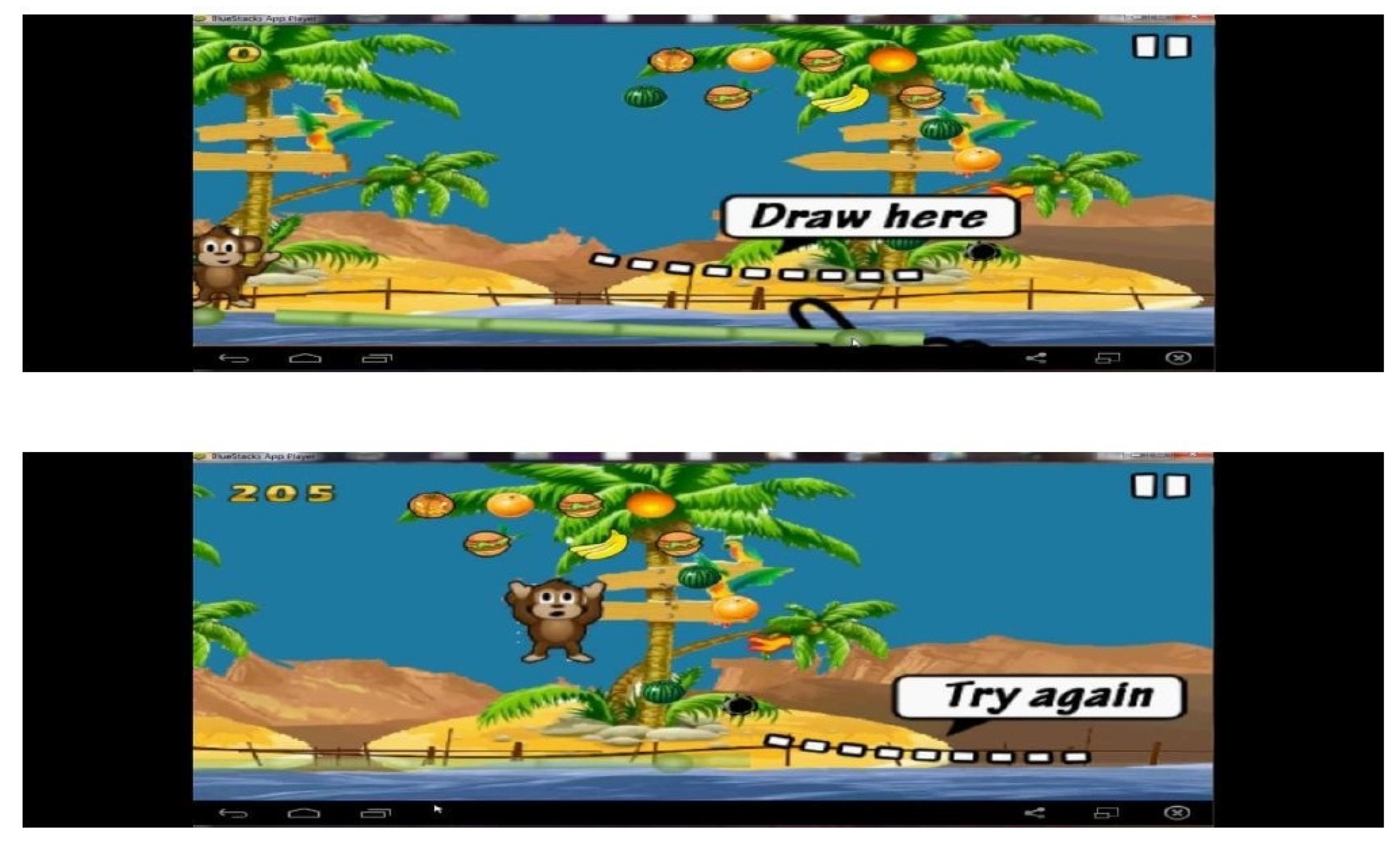
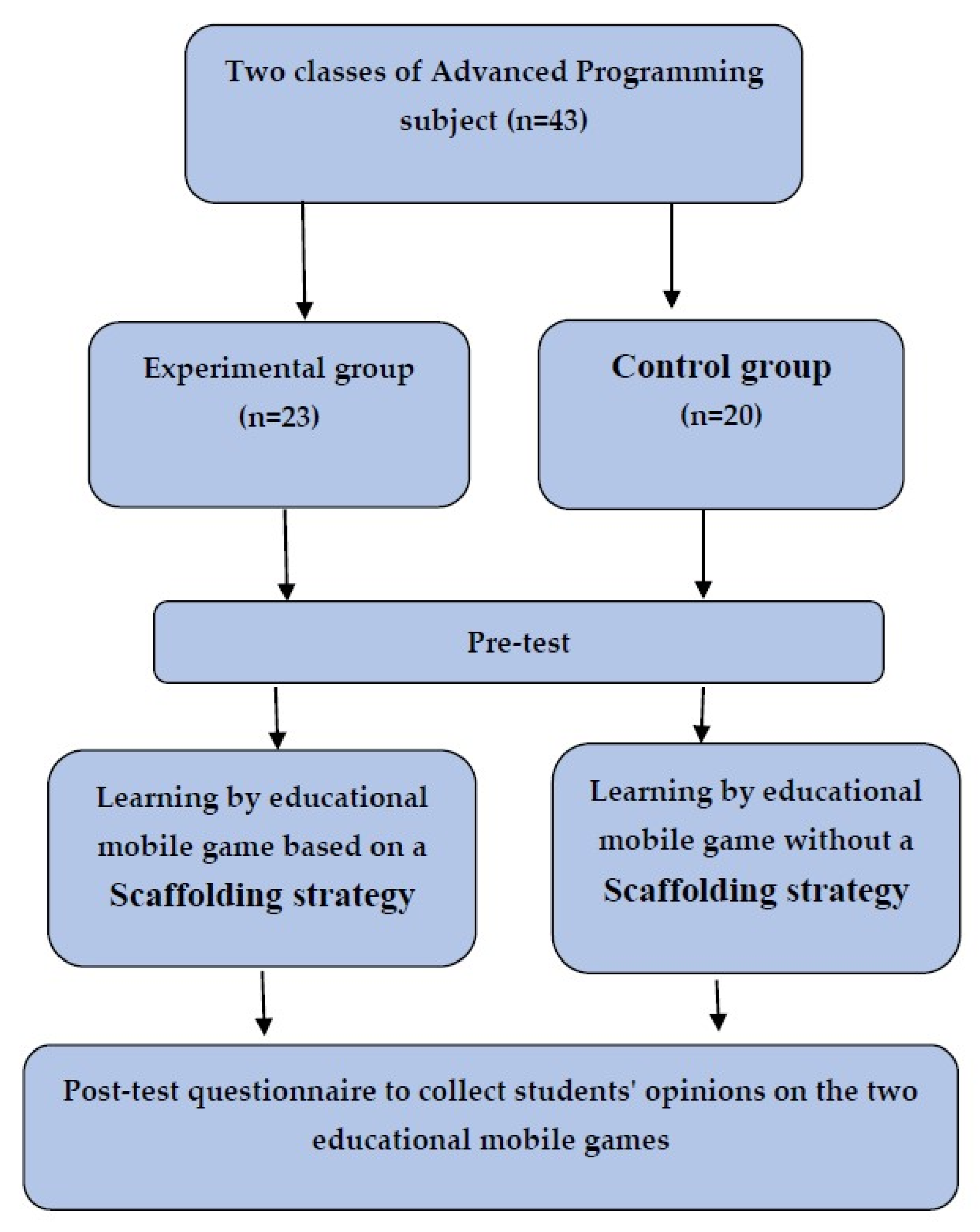
| Hypotheses | Experimental Group (Mobile Game with Scaffolding Strategy) | Control Group (Mobile Game without Scaffolding Strategy) | ||||
|---|---|---|---|---|---|---|
| (β) Value | T-Value | Results | (β) Value | T-Value | Results | |
| H1:PEU―PEJ | 0.66 | 1.62 | Supported | 0.42 | 1.12 | Supported |
| H2:PEU―PU | 0.33 | 1.45 | Supported | 0.080 | 0.11 | Not Supported |
| H3:PEU―BI | 0.45 | 1.54 | Supported | 0.031 | 0.01 | Not Supported |
| H4:PU―BI | 0.78 | 1.75 | Supported | 0.021 | 0.08 | Not Supported |
| H5:PEJ―BI | 0.92 | 1.85 | Supported | 0.38 | 1.41 | Supported |
| H6:PEJ―EFF | 0.84 | 1.79 | Supported | 0.22 | 1.30 | Supported |
| H7:PEJ―EFC | 0.71 | 1.72 | Supported | 0.011 | 0.06 | Not Supported |
| H8:BI―UT | 0.62 | 1.61 | Supported | 0.42 | 1.35 | Supported |
| H9:EFF―UT | 0.32 | 1.40 | Supported | 0.37 | 1.22 | Supported |
| H10:EFC―UT | 0.52 | 1.51 | Supported | 0.36 | 1.39 | Supported |
Publisher’s Note: MDPI stays neutral with regard to jurisdictional claims in published maps and institutional affiliations. |
© 2021 by the authors. Licensee MDPI, Basel, Switzerland. This article is an open access article distributed under the terms and conditions of the Creative Commons Attribution (CC BY) license (https://creativecommons.org/licenses/by/4.0/).
Share and Cite
Al Mulhem, A.; Almaiah, M.A. A Conceptual Model to Investigate the Role of Mobile Game Applications in Education during the COVID-19 Pandemic. Electronics 2021, 10, 2106. https://doi.org/10.3390/electronics10172106
Al Mulhem A, Almaiah MA. A Conceptual Model to Investigate the Role of Mobile Game Applications in Education during the COVID-19 Pandemic. Electronics. 2021; 10(17):2106. https://doi.org/10.3390/electronics10172106
Chicago/Turabian StyleAl Mulhem, Ahmed, and Mohammed Amin Almaiah. 2021. "A Conceptual Model to Investigate the Role of Mobile Game Applications in Education during the COVID-19 Pandemic" Electronics 10, no. 17: 2106. https://doi.org/10.3390/electronics10172106
APA StyleAl Mulhem, A., & Almaiah, M. A. (2021). A Conceptual Model to Investigate the Role of Mobile Game Applications in Education during the COVID-19 Pandemic. Electronics, 10(17), 2106. https://doi.org/10.3390/electronics10172106







